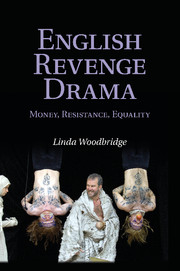Book contents
- Frontmatter
- Contents
- List of figures
- Acknowledgments
- English revenge plays discussed in this book
- Standard MLA abbreviations for Shakespeare's plays
- Note on the text
- PART I RAMPANT REVENGE
- PART II ECONOMIC UNFAIRNESS: REVENGE AND MONEY
- PART III POLITICAL UNFAIRNESS: REVENGE AND RESISTANCE
- PART IV SOCIAL UNFAIRNESS: VENGEANCE AND EQUALITY
- 9 Revenge and class warfare
- 10 Quantification revisited: revenge and social equality
- Conclusion
- Bibliography
- Index
9 - Revenge and class warfare
Published online by Cambridge University Press: 06 December 2010
- Frontmatter
- Contents
- List of figures
- Acknowledgments
- English revenge plays discussed in this book
- Standard MLA abbreviations for Shakespeare's plays
- Note on the text
- PART I RAMPANT REVENGE
- PART II ECONOMIC UNFAIRNESS: REVENGE AND MONEY
- PART III POLITICAL UNFAIRNESS: REVENGE AND RESISTANCE
- PART IV SOCIAL UNFAIRNESS: VENGEANCE AND EQUALITY
- 9 Revenge and class warfare
- 10 Quantification revisited: revenge and social equality
- Conclusion
- Bibliography
- Index
Summary
in 1549 a.d. robert kett yeoman farmer of wymondham was executed by hanging in this castle after the defeat of the norfolk rebellion of which he was the leader. in 1949 a.d., four hundred years later, this memorial was placed here by the citizens of norwich in reparation and honour to a notable and courageous leader in the long struggle of the common people of england to escape from a servile life into the freedom of just conditions
In 2 Henry VI, one of Shakespeare's earliest plays, the tradesman revolutionary Jack Cade commands, “Set London Bridge afire” and “burn down the Tower too.” (The king and queen are barricaded there.) When a rebel reports, “London Bridge is afire!” Cade issues an electrifying decree: “Henceforward all things shall be in common.” He will abolish social distinction – “it was never merry world in England since gentlemen came up” (4.2.6–7), demoting “kings and princes” (4.2.33). That early modern specter, armed revolt promoting economic communism and social equality, was a nightmare or a beatific vision, depending on whether one wore starched ruff or leather jerkin. And many violent avengers are levelers.
For two centuries, class wars had kept Europe in flames, swelling to a tsunami of violence in the 1520s and 1530s. In Part II, on resistance, I focused on the lone avenger (sometimes with a few confederates). But sometimes a whole oppressed class resisted. Such rebellions were usually crushed.
- Type
- Chapter
- Information
- English Revenge DramaMoney, Resistance, Equality, pp. 225 - 253Publisher: Cambridge University PressPrint publication year: 2010



